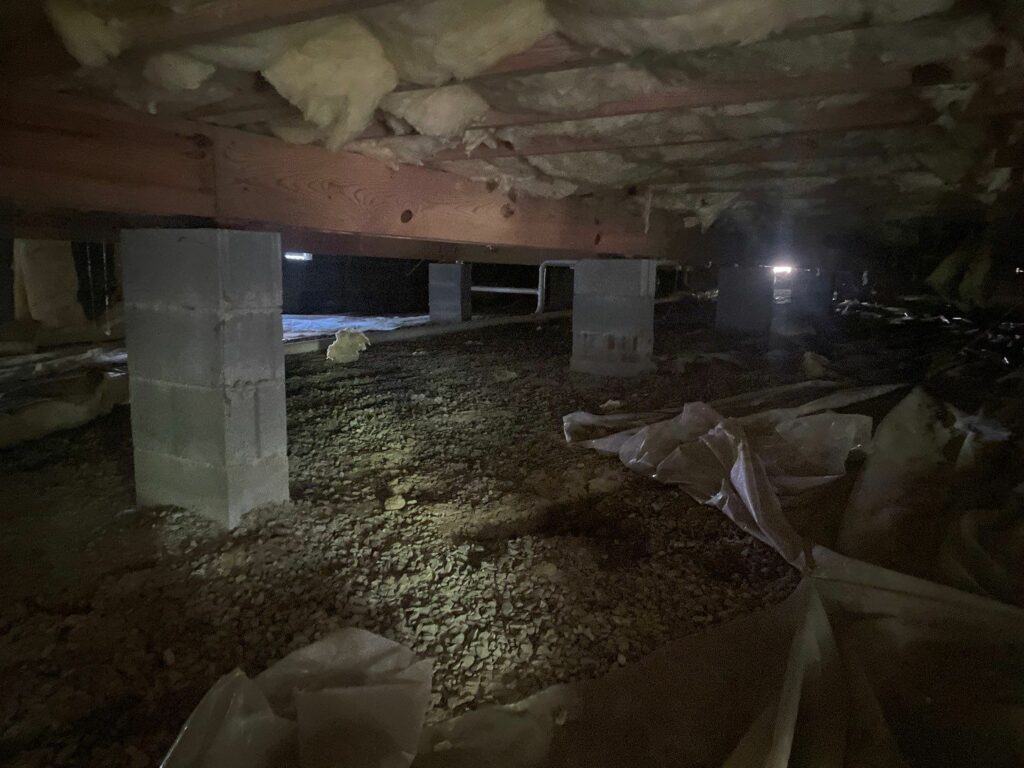Crawl Space Waterproofing
Crawl Space French Drain Installation
A crawl space waterproofing system or crawl space french drain is a type of drainage system that can help prevent water from accumulating in your crawl space and causing damage to your home’s foundation, walls, floors, and insulation. A crawl space French drain consists of a perforated pipe buried in a trench along the perimeter of your crawl space and connected to a sump pump that pumps out the water to a safe location away from your home. A crawl space French drain can also be combined with other crawl space repair solutions, such as vapor barriers, dehumidifiers, and encapsulation, to create a dry and healthy crawl space.

What is a Crawl Space French Drain?
A crawl space French drain is named after Henry French, a 19th-century American farmer and judge who popularized using perforated pipes to drain water from wet areas. It is also known as a perimeter drain, a footing drain, or a weeping tile.
A crawl space French drain collects water seeping through the soil around your home’s foundation and directs it to a sump pump that discharges it away from your home. This prevents water from pooling in your crawl space and causing problems such as mold growth, wood rot, pest infestation, structural damage, and poor indoor air quality.
What Makes Up A Complete Crawl Space Waterproofing System
- Perforated pipe: This is the main part of the French drain that collects the water from the soil. The pipe is usually made of PVC or corrugated plastic and has small holes along its length that allow water to enter. The pipe is laid in a trench that follows the contour of your crawl space floor and slopes slightly towards the sump pump.
- Filter fabric: This is a geotextile material that wraps around the perforated pipe and prevents soil and debris from clogging the pipe. The filter fabric also helps stabilize the trench and prevent erosion.
- Gravel bed: This is a layer of coarse gravel that fills the trench around the perforated pipe and filter fabric. The gravel bed provides support for the pipe and creates a porous medium for water to flow through.
- Sump pump: This is an electric device that pumps out the water collected by the French drain to a safe location away from your home. The sump pump is usually installed in a sump pit or basin that is dug at the lowest point of your crawl space. The sump pump should have a check valve that prevents water from flowing back into the pit and a backup battery or generator in case of power outage.
- Discharge line: This is a solid pipe that connects the sump pump to the discharge location. The discharge line should be buried below the frost line and have an air gap or vent to prevent backflow of water or sewer gases. The discharge location should be downhill from your home and away from any structures, wells, or septic systems.
How Do I Know if I Need a Crawl Space Waterproofing System?
If you have signs of water intrusion or moisture problems in your crawl space, such as standing water, dampness, musty odors, mold growth, wood rot, rusting metal, sagging insulation, or buckling floors, you may need a crawl space French drain to solve these issues.
However, before installing a crawl space French drain, you should first identify and fix any sources of water leakage or infiltration into your crawl space, such as roof leaks, gutter problems, grading issues, foundation cracks, or plumbing leaks. These sources may contribute to or worsen your crawl space moisture problems and reduce the effectiveness of your French drain.
Foundation drainage problems manifest themselves in different ways. It’s important that you keep an eye out for every possible indicator that you have foundation drainage problems so that you know when it’s time to contact a foundation expert before the structural damage gets worse.
Standing Water
The most obvious sign of a crawl space drainage problem is standing water. No matter how common it is for many homeowners with a crawl space, a foundation should never be flooded. Take a look inside your crawl space after it rains, and check to see if there is any water in the crawl space. You might want to check during the rainy season when the water table is most likely to rise and the crawl space is most likely to get flooded with water. In Charlotte, the rainy season starts in May and ends in August.
Mold
If there’s any water entering your crawl space, then there will most likely also be mold growth. Mold loves damp, dark places where the sun doesn’t shine, so crawl spaces are ideal. Mold can show up anywhere on your crawl space, including the concrete. Mold stains on concrete can be black or green, so make sure you have a flashlight with you when inspecting the crawl space.
Wood Rot
Wood rot is when wood gets infected with a fungal growth that slowly deteriorates the wood. Fungus is a microorganism that needs organic matter to survive, as well as water. If your crawl space has a drainage issue, then it won’t lack a water source, and the wood acts as a source of nutrition. When wood is infected with wood rot, some discoloration appears. The stains can be white, green, black, gray, or yellow
Efflorescence
Efflorescence is a type of stain that shows up on your concrete. It occurs when the moisture in concrete rises to the surface and brings with it all the salts and minerals within the structure. The water evaporates, but the salts can’t do the same; so, they simply stay clumped up on the surface of the concrete, forming the white stain that you see. Efflorescence is a sign that your wall is being exposed to too much moisture. An interior drainage system will be able to scoop up all the water that flows down a crawl space wall so that it doesn’t get absorbed by the concrete.
Crawl Space Encapsulation Before & After

Before

After
Crawl Space Waterproofing FAQs
Blank
The cost of installing a French drain in a crawl space depends on several factors, such as the size and condition of your crawl space, the length and depth of the trench, the type and quality of the materials, the labor and equipment required, and the location and accessibility of your home. According to HomeAdvisor, the average cost of installing a French drain in a crawl space ranges from $2,000 to $15,000, with most homeowners spending around $5,000.
Some of the main components that affect the cost of installing a French drain in a crawl space are:
The perforated pipe: This is the core element of the French drain that collects and transports the water. The pipe can be made of PVC or corrugated plastic, and it usually costs between $0.50 and $2 per linear foot. The pipe size can vary from 3 to 6 inches in diameter, depending on the amount of water expected.
The filter fabric: This is the geotextile material that wraps around the pipe and prevents soil and debris from clogging it. The filter fabric can cost between $0.15 and $0.40 per square foot.
The gravel: This is the coarse material that fills the trench around the pipe and filter fabric. The gravel can cost between $10 and $50 per cubic yard, depending on the type and quality. The gravel size can range from 0.5 to 1.5 inches in diameter, depending on the soil conditions.
The sump pump: This is the device that pumps out the water collected by the French drain to a safe location away from your home. The sump pump can cost between $100 and $5001, depending on the power and capacity. The sump pump size can vary from 1/4 to 3/4 horsepower, depending on the water volume2.
The discharge line: This is the solid pipe that connects the sump pump to the discharge location. The discharge line can cost between $1 and $4 per linear foot, depending on the material and diameter. The discharge line size can range from 1.5 to 4 inches in diameter, depending on the water flow.
The labor: This is the amount of work involved in digging the trench, laying the pipe, filling the gravel, installing the sump pump, and running the discharge line. The labor can cost between $30 and $100 per hour, depending on the contractor’s experience and reputation. The labor time can vary from 8 to 40 hours, depending on the complexity of the project.
To get an accurate estimate of how much it will cost to install a french drain in your crawl space, you should contact a professional crawl space contractor like RhinoLift who can inspect your situation and provide you with a customized quote.
The lifespan of a French drain in a crawl space depends on several factors, such as the quality of the installation, the maintenance frequency, the soil conditions, and the weather patterns. Generally speaking, a well-installed and well-maintained French drain can last for 20 to 30 years or more.
Some of the main factors that affect the longevity of a French drain in a crawl space are:
The quality of the installation: A properly installed french drain should have a sufficient slope, adequate drainage area, appropriate pipe size, sufficient gravel bed, proper filter fabric, reliable sump pump, and secure discharge line. A poorly installed french drain may have problems such as clogging, leaking, collapsing, or freezing.
The maintenance frequency: A regularly maintained French drain should be inspected and cleaned at least once a year or more often if needed. A neglected French drain may accumulate dirt, debris, roots, or sediment that can reduce its effectiveness or damage its components.
The soil conditions: The type and texture of the soil around your home can affect how fast or slow water drains through it. Clay soils tend to hold water longer than sandy soils, which can increase the pressure on your foundation walls and your French drain. The soil pH can also affect the corrosion of the pipe and the sump pump over time.
The weather patterns: The amount and frequency of rainfall or snowfall in your area can affect how much water enters your crawl space and your French drain. Heavy or prolonged precipitation can overwhelm your French drain system and cause flooding or backup. Extreme temperatures can also cause freezing or thawing of the water in your French drain, which can damage the pipe or the sump pump.
To extend the life of your french drain in your crawl space, you should follow RhinoLift’s instructions for the care and maintenance of your system. You should also consult with a professional crawl space contractor like RhinoLift who can monitor and service your French drain regularly and address any issues or repairs promptly.
A French drain and a trench drain are both types of drainage systems that can help prevent water from accumulating in your crawl space and causing damage to your home. However, they have different designs, functions, and applications.
A French drain is a perforated pipe that is buried in a gravel-filled trench along the perimeter of your crawl space, and connected to a sump pump that pumps out the water to a safe location away from your home. A French drain is designed to collect and divert groundwater that seeps through the soil around your foundation and into your crawl space.
A trench drain is a solid channel that is installed on the surface of your crawl space floor, and connected to a drainage pipe that leads to a storm sewer or a dry well. A trench drain is designed to capture and convey surface water that flows into your crawl space from outside sources, such as rainwater, melting snow, or runoff.
Some of the main differences between a French drain and a trench drain are:
The installation: A French drain requires digging a trench around the entire crawl space, while a trench drain requires cutting a channel across the crawl space floor. A French drain is more labor-intensive and invasive than a trench drain.
The appearance: A French drain is hidden underground and covered with soil or sod, while a trench drain is visible on the floor and covered with a grate or a slot. A French drain is more discreet and aesthetic than a trench drain.
The performance: A French drain can handle more water volume and pressure than a trench drain, as it has more surface area and depth to collect and transport water. A French drain is more effective and reliable than a trench drain for groundwater drainage.
The maintenance: A French drain requires less maintenance than a trench drain, as it has less exposure to dirt, debris, leaves, or trash that can clog it. A French drain only needs occasional inspection and cleaning, while a trench drain needs regular sweeping and flushing.
To determine which type of drainage system is best for your crawl space, you should consult with a professional crawl space contractor like RhinoLift who can assess your situation and recommend the most suitable solution for your home.
Contact Us For Professional Crawl Space Waterproofing Services In Charlotte and the Surrounding Areas
As a reputable foundation repair company serving Charlotte, NC, and surrounding areas, RhinoLift is dedicated to providing top-notch services to homeowners facing foundation damage concerns. Our team of skilled contractors understands the importance of ensuring the safety and well-being of our clients and the longevity of their homes. We offer complimentary inspections and detailed service quotes to Charlotte homeowners, allowing us to accurately assess the extent of the foundation damage and provide an effective repair plan. You can trust us to implement the best strategy tailored to your specific needs, whether it’s addressing bowing walls, tilting walls, or other foundation issues.
Contact our RhinoLift Foundation & Crawl Space Repair team by calling 888-758-3735 to schedule an appointment. You can also click the button below to fill out our online contact form for a free crawl space inspection.

